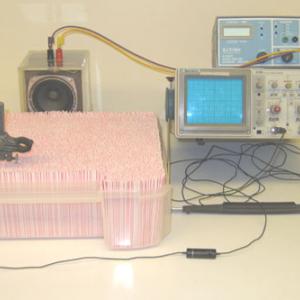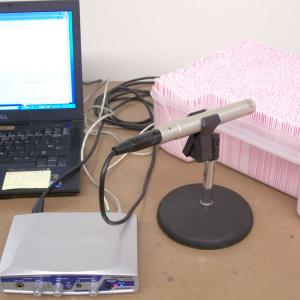College of Liberal Arts & Sciences
3C55.86 - Sound Sink-Sound Sucker
Remove the lid from the sound sucker container. Place the speaker so that it just clears the top of the straws. Adjust the frequency until the intensity diminishes. ( Frequencies should be in the neighborhood of 660, 2000, and 3200 Hz. ) Position the microphone on the side opposite the speaker. As you move the sound sucker away from this initial position you should see the amplitude of the waveform on the oscilloscope increase.
The pipes with holes down the length have a “band gap” like a semiconductor due to the periodic holes. In musical instruments like a clarinet it is called the “tone-hole cut-off”. Tone holes are not periodic, but the effect is similar.
- Chris Chiaverina, "Little Gems - A Sound Sink", TPT, Vol. 46, # 5, p. 314, May 2008.
- Alan Hall, "Shaping Sound", Scientific American, Dec. 21, 1998. https://www.scientificamerican.com/article/shaping-sound/
- Eleanor Cummins, Natalie Andrewson, "Tales From the Field", Popular Science, Winter 2019, p. 97.
- William Beaty, "Sound Sucker, 'Acoustic Illusion'", William Beaty, http://www.amasci.com
- W. Bolton, "Sound Filter", Book 2 - Waves and Particles, Physics Experiments and Projects, 1968, p. 86.
- W. Bolton, "Transmission of Sound Through Windows", Book 2 - Waves and Particles, Physics Experiments and Projects, 1968, p. 87-88.
Disclaimer: These demonstrations are provided only for illustrative use by persons affiliated with The University of Iowa and only under the direction of a trained instructor or physicist. The University of Iowa is not responsible for demonstrations performed by those using their own equipment or who choose to use this reference material for their own purpose. The demonstrations included here are within the public domain and can be found in materials contained in libraries, bookstores, and through electronic sources. Performing all or any portion of any of these demonstrations, with or without revisions not depicted here entails inherent risks. These risks include, without limitation, bodily injury (and possibly death), including risks to health that may be temporary or permanent and that may exacerbate a pre-existing medical condition; and property loss or damage. Anyone performing any part of these demonstrations, even with revisions, knowingly and voluntarily assumes all risks associated with them.


